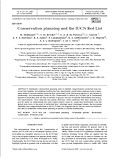| Journal Article |
 |
|
| Article Title | Conservation planning and the IUCN Red List | | Author | M.Hoffmann, Thomas M. Brooks, Gustavo A. B. da Fonseca, C. Gascon, A. F. A. Hawkins, R. E. James, P. Langhammer, Russell A. Mittermeier, J.D.Pilgrim, Ana S. L. Rodrigues and J. M. C. Silva | | Year | 2008 | | Journal Title | Endangered Species Research | | Institution | Inter-Research | | Volume | 6 | | Pages | 113–125 | | Call Number | JA0320-09 | | Keywords | IUCN Red List · Conservation planning · Threatened species · Biodiversity
conservation · Protected areas |
|
| Abstract: |
| Systematic conservation planning aims to identify comprehensive protected area networks that together will minimize biodiversity loss. Importantly, conservation planners seek to determine where to allocate limited resources first, particularly given the uneven spread of, and threats to, biodiversity. The International Union for the Conservation of Nature (IUCN) Red List of Threatened Species incorporates data not only on threats to species, but also on species distributions and ecological requirements. These temporal and spatial attributes, when combined with other datasets, have proven useful for determining the most urgent priority areas for conserving biodiversity, from the global level down to the scale of individual sites. Although many challenges remain, the increasing reliability and comprehensiveness of the IUCN Red List suggests that its role as a source of biodiversity data in systematic conservation planning is certain to expand dramatically. |
|
|
Download file(s): Click icon to download/open file.
|
|
|
|
GRP 1: Domestication, utilization andconservation ofsuperior agroforestry germplasm
|
| Viewed in 2165 times. Downloaded in 0 times. |
